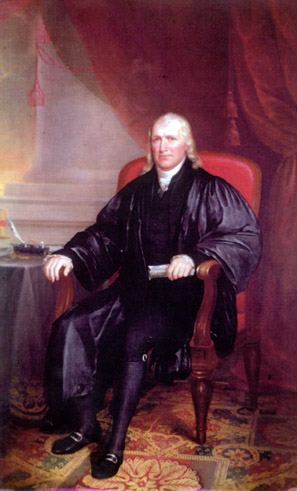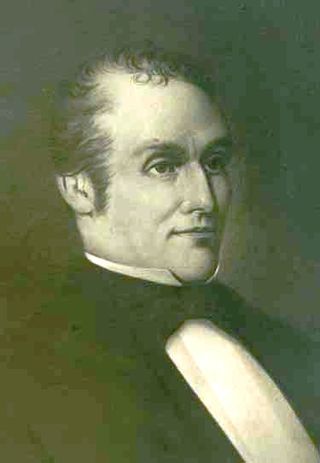
Impeachment is a process by which a legislative body or other legally constituted tribunal initiates charges against a public official for misconduct. It may be understood as a unique process involving both political and legal elements.

Samuel Chase was a Founding Father of the United States, signer of the Continental Association and United States Declaration of Independence as a representative of Maryland, and Associate Justice of the United States Supreme Court. In 1804, Chase was impeached by the House of Representatives on grounds of letting his partisan leanings affect his court decisions, but was acquitted the following year by the Senate and remained in office. He is the only United States Supreme Court Justice to have ever been impeached.

The New Hampshire Supreme Court is the supreme court of the U.S. state of New Hampshire and sole appellate court of the state. The Supreme Court is seated in the state capital, Concord. The Court is composed of a Chief Justice and four Associate Justices appointed by the Governor and Executive Council to serve during "good behavior" until retirement or the age of seventy. The senior member of the Court is able to specially assign lower-court judges, as well as retired justices, to fill vacancies on the Court.

There have been 91 gubernatorial elections in the state of New York since 1777, with the most recent being held on November 8, 2022. The next election is scheduled to be held on November 3, 2026.
In the United States, impeachment is the process by which a legislature may bring charges against an officeholder for misconduct alleged to have been committed with a penalty of removal. Impeachment may also occur at the state level if the state or commonwealth has provisions for it under its constitution. Impeachment might also occur with tribal governments as well as at the local level of government.

The majority leader of the New York State Senate is elected by the majority of the members of the New York State Senate. The position usually coincides with the title of temporary president of the State Senate, who presides over the session of the State Senate if the lieutenant governor of New York is absent. The temporary president of the State Senate becomes acting lieutenant governor for the remainder of the unexpired term in case of a vacancy in the office of lieutenant governor, or until a new lieutenant governor is appointed In case of a vacancy in the offices of both the governor and lieutenant governor at the same time, the temporary president of the State Senate becomes Acting Governor. If the double vacancy occurs until three months before the mid-term state elections, a special election for governor of New York and lieutenant governor is held. If the double vacancy occurs later, the Temporary President of the State Senate acts as governor until the end of the unexpired term. The temporary president of the State Senate retains both majority leadership and a seat in the State Senate while acting as lieutenant governor or governor.
The Constitution of the State of New York establishes the structure of the government of the State of New York, and enumerates the basic rights of the citizens of New York. Like most state constitutions in the United States, New York's constitution's provisions tend to be more detailed and amended more often than its federal counterpart. Because the history of the state constitution differs from the federal constitution, the New York Court of Appeals has seen fit to interpret analogous provisions differently from United States Supreme Court's interpretation of federal provisions.

Addison Gardiner was an American lawyer and politician who served as the lieutenant governor of New York from 1845 to 1847 and Chief Judge of the New York Court of Appeals from 1854 to 1855.

The 1974 New York state election was held on November 5, 1974, to elect the governor, the lieutenant governor, the state comptroller, the attorney general, two judges of the New York Court of Appeals and a U.S. Senator, as well as all members of the New York State Assembly and the New York State Senate.

The government of Arizona is the governmental structure of the state of Arizona as established by the Arizona Constitution. The executive is composed of the Governor, several other statewide elected officials, and the Governor's cabinet. The Arizona Legislature consists of the House of Representatives and Senate. The judiciary is composed of the Arizona Supreme Court and lower courts. There is also local government, consisting of counties, municipalities and special districts.

Theophilus Washington Smith was an Illinois Supreme Court Justice from 1825 until his resignation on December 26, 1842. He holds the distinction of being the subject of Illinois's first impeachment trial, held in 1833.

The 136th New York State Legislature, consisting of the New York State Senate and the New York State Assembly, met from January 1 to December 12, 1913, while William Sulzer, and then Martin H. Glynn, were Governor of New York, in Albany.

The 177th New York State Legislature, consisting of the New York State Senate and the New York State Assembly, met from January 4, 1967, to May 25, 1968, during the ninth and tenth years of Nelson Rockefeller's governorship, in Albany.
Samuel Chase, an associate justice of the Supreme Court of the United States, was impeached by the United States House of Representatives on March 12, 1804 on eight articles of impeachment alleging misconduct. His impeachment trial before the United States Senate delivered an acquittal on March 1, 1805, with none of the eight articles receiving the two-thirds majority needed for a conviction.

In the United States, a federal impeachment trial is held as the second stage of the United States federal government's bifurcated (two-stage) impeachment process. The preceding stage is the "impeachment" itself, held by a vote in the United States House of Representatives. Federal impeachment trials are held in the United States Senate, with the senators acting as the jurors. At the end of a completed impeachment trial, the U.S. Senate delivers a verdict. A "guilty" verdict has the effect of immediately removing an officeholder from office. After, and only after, a "guilty" verdict, the Senate has the option of additionally barring the official from ever holding federal office again, which can be done by a simple-majority vote.

In the United States, federal impeachment is the process by which the House of Representatives charges the president, vice president, or another civil federal officer for alleged misconduct. The House can impeach an individual with a simple majority of the present members or other criteria adopted by the House according to Article One, Section 2, Clause 5 of the U.S. Constitution.

Similar to the Congress of the United States, state legislatures can impeach state officials, including governors and judicial officers, in every state except Oregon. In addition, the legislatures of the territories of American Samoa, Northern Mariana Islands, and Puerto Rico have impeachment powers. Impeachment describes the process through which the legislature may bring charges and hold a trial with a penalty including removal from office.
The constitution of the U.S. state of Alabama grants its legislature the ability to impeach and remove certain officials. An impeachment vote in the Alabama House of Representatives is followed by an impeachment trial in the Alabama Senate through which an official can be removed from office if convicted.
Impeachment in Wisconsin is the main process by which the Wisconsin Legislature can bring charges and decide whether to remove state officers from their positions. A simple majority of the Wisconsin State Assembly can impeach an officer, after which the Wisconsin Senate acts as the court of trial, where a two-thirds majority is required to convict. In the event of a conviction, the punishment may be removal from office or removal and disqualification to hold state office.